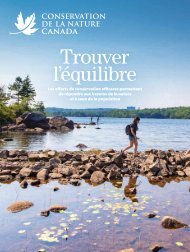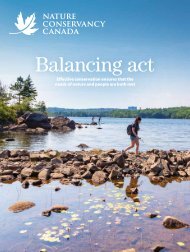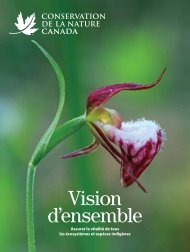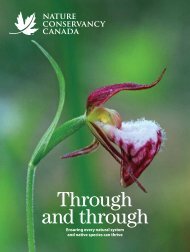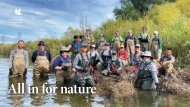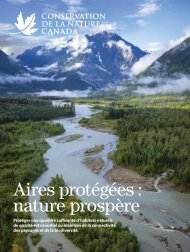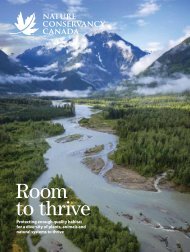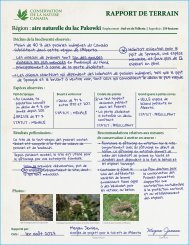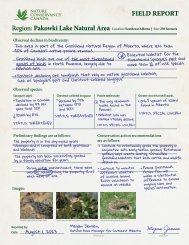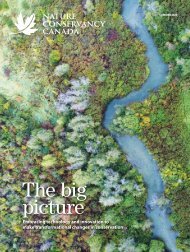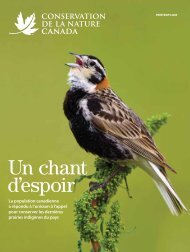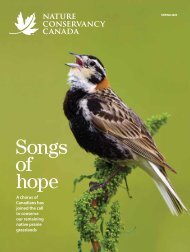NCC Magazine - Winter 2023
Create successful ePaper yourself
Turn your PDF publications into a flip-book with our unique Google optimized e-Paper software.
WINTER <strong>2023</strong><br />
Shoulder<br />
to shoulder<br />
TKTKTKTKTKTKT<br />
Sharing the path to conservation success with<br />
Canadians from all walks of life<br />
natureconservancy.ca<br />
WINTER 2021 1
WINTER <strong>2023</strong><br />
CONTENTS<br />
Nature Conservancy of Canada<br />
4 Deep snooze<br />
Learn about how<br />
some animals bear<br />
the Canadian winters.<br />
6 Protecting<br />
peatland<br />
A protected area of<br />
ecologically significant<br />
peatland.<br />
7 Tree ID<br />
Tips on identifying trees<br />
in the winter.<br />
7 Let’s dance<br />
The wild landscapes of the<br />
Yukon set the stage for dancing.<br />
8 A seat for everyone<br />
at the table<br />
In communities across the<br />
country, people of all<br />
backgrounds are working<br />
together to care for nature.<br />
12 Made for snow<br />
With its snowshoe-like paws<br />
and thick hair, Canada lynx<br />
thrives in deep snow.<br />
14 Puzzle pieces<br />
Diane Griffin on conserving<br />
Prince Edward Island land,<br />
piece by piece.<br />
16 Project updates<br />
Investing in tomorrow’s leaders;<br />
other effective area-based<br />
conservation measures; NHCP<br />
program extension.<br />
18 Some dreams do<br />
come true<br />
A childhood dream comes true<br />
in Saskatchewan.<br />
Digital extras<br />
Check out our online magazine page with<br />
additional content to supplement this issue,<br />
at nccmagazine.ca.<br />
Nature Conservancy of Canada<br />
245 Eglinton Ave. East, Suite 410 | Toronto, Ontario, Canada M4P 3J1<br />
magazine@natureconservancy.ca | Phone: 416.932.3202 | Toll-free: 877.231.3552<br />
The Nature Conservancy of Canada (<strong>NCC</strong>) is the country’s unifying force for nature. We seek<br />
solutions to the twin crises of rapid biodiversity loss and climate change through large-scale,<br />
permanent land conservation. <strong>NCC</strong> is a registered charity. With nature, we build a thriving world.<br />
The Nature Conservancy of Canada <strong>Magazine</strong> is distributed to donors and supporters of <strong>NCC</strong>.<br />
TM<br />
Trademarks owned by the Nature Conservancy of Canada.<br />
FSC is not responsible for any calculations on<br />
saving resources by choosing this paper.<br />
Printed on Enviro100 paper, which contains 100% post-consumer fibre, is EcoLogo, Processed Chlorine Free<br />
certified and manufactured in Canada by Rolland using biogas energy. Printed in Canada with vegetable-based<br />
inks by Warrens Waterless Printing. This publication saved 163 trees and 54,252 litres of water*.<br />
TKTKTKTKTKTKT<br />
GENERATED BY: CALCULATEUR.ROLLANDINC.COM. PHOTO: JENNA RACHELLE. COVER: GUILLAUME SIMONEAU.<br />
*<br />
2 FALL 2022 natureconservancy.ca
PEI National Park.<br />
TKTKTKTKTKTKT<br />
FROM TOP: GENEVIEVE LESIEUR; COURTESY JACQUES PERRAULT; COURTESY JOHN E. MARRIOTT.<br />
Dear friends,<br />
Last December, Canada welcomed the world in Montreal for<br />
COP15. Dubbed the NatureCOP, this UN Biodiversity conference<br />
set the stage for what the world will work toward between now<br />
and 2030 to halt and reverse the loss of nature. The Nature Conservancy<br />
of Canada (<strong>NCC</strong>) was there, as part of the Canadian delegation, and in its<br />
own right as an accredited observer organization under the Convention<br />
for Biological Diversity. We actively participated, showcased <strong>NCC</strong> expertise<br />
and projects that deliver on-the-ground results, and voiced our ambition<br />
to achieve a nature-positive future. Already a reliable partner to all<br />
governments in Canada, <strong>NCC</strong> has a plan to protect and conserve more<br />
critical biodiversity habitats, faster, by partnering with the private sector<br />
and local communities. <strong>NCC</strong> also acknowledges the critical role of indigenous<br />
Peoples in meeting these goals, as they have protected and<br />
cared for the natural areas, plants and wildlife that have sustained them<br />
for millennia. When nature thrives, people thrive, and resilient landscapes<br />
require collaboration for long-term success!<br />
After participating in two weeks of intense discussions, <strong>NCC</strong> was<br />
thrilled to join the world in celebrating all delegates in the successful<br />
signing of a global agreement to protect the world’s biodiversity. The<br />
plan provides a framework for conservation organizations, individuals,<br />
governments and groups to deliver on its ambitious goals.<br />
We are committed to leading through innovation, enabling new ways<br />
to accelerate conservation through such means as supporting Indigenous<br />
Protected and Conserved Areas, other effective means of conservation<br />
and new sources of private investment in conservation.<br />
With <strong>NCC</strong>, you are accelerating the pace of conservation in Canada,<br />
which has global impact. This issue’s feature story explores what can<br />
happen when people from all sectors of society come together with<br />
a common vision of building a thriving world with nature. Together, we<br />
can, and must, do more. We need to find our collective footing and help<br />
each other activate solutions.<br />
We know there has never been a more important time for nature, nor<br />
a greater need for the mission of the Nature Conservancy of Canada. Our<br />
strategic plan supports the Global Biodiversity Framework’s goals. We<br />
are already accelerating the pace of conservation, and are ready to do<br />
more, to build a thriving world with nature. Because when nature thrives,<br />
we all thrive.<br />
Thank you as always for your ongoing support,<br />
Catherine Grenier<br />
Catherine Grenier<br />
President and CEO, <strong>NCC</strong><br />
Featured<br />
Contributors<br />
Jacques Perrault is a<br />
professional illustrator<br />
and former art director<br />
at an advertising agency.<br />
He has illustrated several<br />
book series, including<br />
for Time-Life, Meredith<br />
and Sunset. He lives and<br />
works in Saint-Adolphe<br />
d’Howard, Quebec.<br />
Jacques illustrated the<br />
map of the Tourbière<br />
de Venise-Ouest Nature<br />
Reserve on page 6.<br />
John E. Marriott is<br />
one of Canada’s premier<br />
professional wildlife<br />
photographers. He<br />
prides himself on being<br />
a conservation photographer<br />
known for<br />
photographing<br />
wilderness scenes and<br />
wild, free-roaming<br />
animals in their natural<br />
habitats. John photographed<br />
the Canada<br />
lynx on pages 12 and 13.<br />
natureconservancy.ca<br />
WINTER <strong>2023</strong> 3
COAST TO<br />
COAST<br />
Richardson’s<br />
ground squirrel<br />
Deep<br />
snooze<br />
Learn about five animals and how<br />
they bear the Canadian winters<br />
We often think of the saying “you snooze, you<br />
lose” as a missed opportunity, but in the case<br />
of certain animals, a good slumber is vital to<br />
their winter survival.<br />
Across the landscape, as the cold permeates and the<br />
days get shorter, the surrounding nature looks more still<br />
too. For some animals, their instinct is to enter a dormant<br />
state to conserve their bodily resources until spring.<br />
This is often referred to as hibernation, though not all<br />
animals that enter a state of dormancy in the winter are<br />
true hibernators.<br />
ALAMY STOCK PHOTO.<br />
4 WINTER <strong>2023</strong> natureconservancy.ca
TOP TO BOTTOM: ALAMY STOCK PHOTO; MIKE CRANE; MIKE DEMBECK; WALTER LATTER; CORY OLSON; MIKE DEMBECK; ALAMY STOCK PHOTO.<br />
Richardson’s<br />
ground<br />
squirrel<br />
Known by many<br />
as gophers, Richardson’s<br />
ground squirrels<br />
have one of the longest<br />
hibernations of any<br />
animal in Canada.<br />
Adult males may enter<br />
hibernation as early<br />
as July and remain<br />
that way for as long<br />
as 210 days. Females<br />
and their young start<br />
their slumber a bit later,<br />
as the ground starts<br />
to freeze in the fall.<br />
They are not seen<br />
again until the snow<br />
and ice start to recede<br />
in March or April.<br />
Some of the places<br />
they’re found:<br />
Hopkins Conservation<br />
Site, Alberta.<br />
Black bear<br />
Contrary to popular belief, bears aren’t true<br />
hibernators; instead they go into torpor. Hibernation<br />
is characterized by a significant reduction in body temperature,<br />
heart rate, breathing rate and metabolic rate. Torpor is a lighter state<br />
of dormancy that typically doesn’t last as long as hibernation. Bears<br />
can wake up from torpor to drink water or give birth, and then go<br />
back to sleep!<br />
Some of the places they’re found:<br />
A couple of bears use <strong>NCC</strong>’s Nebo project in Saskatchewan regularly,<br />
including a female with cubs.<br />
Gartersnake<br />
A nice group huddle is how common<br />
gartersnakes, the most widespread of several<br />
species of gartersnakes found in Canada,<br />
like to get through the winter. While some<br />
snakes are solitary, gartersnakes congregate<br />
in a hibernaculum, a refuge used during<br />
a period of winter dormancy. For snakes, this<br />
dormancy is called brumation.<br />
Some of the places they’re found:<br />
Most <strong>NCC</strong>-protected areas in southern BC.<br />
Wood frog<br />
Pulling a duvet over your head is what many people do to “hibernate.” So<br />
do wood frogs, sort of! This species finds a crevice in a log or a thick pile<br />
of leaves and settles in for brumation. These frogs also have anti-freeze<br />
proteins to help them survive the deep cold of winter.<br />
Some of the places they’re found:<br />
Most wooded <strong>NCC</strong> properties from Outaouais to Gaspésie, Quebec.<br />
Little brown bat<br />
In late summer and fall, little brown bats migrate from their summer roosts to caves<br />
and mines, where they hibernate from October/November to March/April. Bats<br />
fly to caves and abandoned mines for hibernation, preferring the humid<br />
environment and above-freezing temperatures they provide. The conditions<br />
that bats favour for hibernacula are unfortunately similar to those that suit<br />
the fungus responsible for white-nose syndrome, a fungal disease that<br />
causes bats to wake up more than usual in hibernation, which depletes<br />
their limited energy reserves. White-nose syndrome is responsible for<br />
massive declines in little brown bat populations.<br />
Some of the places they’re found:<br />
Little brown bats have the widest distribution of all bat species in<br />
Canada. <strong>NCC</strong> nature reserves throughout the Prairies provide important<br />
foraging and breeding habitat for this species.<br />
natureconservancy.ca<br />
WINTER <strong>2023</strong> 5
BOOTS ON<br />
THE TRAIL<br />
Montée Roy<br />
<br />
N<br />
Tourbière de<br />
Venise-Ouest<br />
Nature Reserve<br />
A protected area of ecologically significant<br />
peatland on the north shore of Lake Champlain<br />
The Tourbière de Venise-Ouest Nature Reserve is on the north<br />
shore of Lake Champlain, 70 kilometres southeast of Montreal.<br />
The Nature Conservancy of Canada-protected area covers<br />
380 hectares, including 80 per cent of the peatland in the reserve.<br />
The peatland here is home to several rare species and serves a<br />
number of important ecological roles, including helping to maintain<br />
the water quality of Missisquoi Bay (in the northern part of Lake<br />
Champlain) by filtering it as it passes through. The peatland also lessens<br />
the impact of the lake’s seasonal flooding, acting as a sponge that initially<br />
absorbs the overflow and then gradually releases it.<br />
As several plants and animals can only be found in peatlands<br />
due to the unique conditions these habitats provide, the peatland’s<br />
presence means greater biodiversity for an entire region. Around<br />
100 bird species, such as least bittern, and several species of mammals,<br />
amphibians and reptiles, such as painted turtle, can be found here.<br />
The peatland is also home to approximately 15 species at risk, one<br />
of which, bog fern, can only be found in two other places in Quebec.<br />
Conserving the peatland is vital for this species’ survival in the province.<br />
Year-round exploring here means more opportunity to connect<br />
with nature. In winter, visitors can strap on cross-country skis and<br />
meander along the snowy landscape. Spring flooding provides a new<br />
perspective on the role and importance of the property’s wetlands.<br />
In summer, the three-kilometre trail, rated easy, offers great views of<br />
the wetlands, so don’t forget your binoculars. And the forests on the<br />
northern part of the trail are a burst of stunning colours come fall.1<br />
Tourbière de<br />
Venise-Ouest<br />
Nature Reserve<br />
Highway 202<br />
Tourbière de<br />
Venise-Ouest<br />
Nature Reserve<br />
★<br />
Étang<br />
John<br />
51e Rue O<br />
✿<br />
For more information, visit natureconservancy.ca/veniseouest<br />
Lake<br />
Champlain<br />
LEGEND<br />
-- Sentier du ruisseau<br />
McFee<br />
-- Sentier de la nature<br />
SPECIES TO SPOT<br />
• blue-spotted<br />
salamander<br />
• blue-winged teal<br />
• bog fern<br />
• eastern kingbird<br />
• eastern phoebe<br />
• eastern screech owl<br />
★ Parking<br />
✿ Interpretive<br />
Centre<br />
• gray treefrog<br />
• hooded merganser<br />
• rose-breasted<br />
grosbeak<br />
• wood duck<br />
• wood frog<br />
LEFT TO RIGHT: MONIQUE LÉTOURNEAU; FRANÇOIS VILLENEUVE; <strong>NCC</strong>;<br />
ROBERT MCCAW. MAP: JACQUES PERRAULT.<br />
6 WINTER <strong>2023</strong><br />
natureconservancy.ca
ACTIVITY<br />
CORNER<br />
BACKPACK<br />
ESSENTIALS<br />
No leaves,<br />
no problem<br />
Tips for tree identification in<br />
the winter months<br />
The distinctive leaves of many trees, such as sugar<br />
maple, can provide a sense of familiarity in spring<br />
and summer. As many trees shed their leaves in the<br />
fall, it can be more challenging to tell them apart.<br />
However, the clues are there — you just have to<br />
know what to look for. Grab a field guide, or an app<br />
like iNaturalist, and read on to become a winter<br />
tree ID pro.<br />
SHAPE<br />
To narrow down a tree<br />
species, start from a distance.<br />
Is the tree a conifer, generally<br />
keeping its needles all year,<br />
or is it deciduous, losing its<br />
leaves in the fall? If it’s deciduous, look at the shape<br />
of the tree. Do the branches spread outward from<br />
the trunk horizontally, or reach vertically toward the<br />
sky? Compare, for example, the narrow profile of<br />
a birch against the wide crown of an oak.<br />
ILLUSTRATION: BELLE WUTHRICH. PHOTO: PETER MATHER.<br />
TWIGS AND BUDS<br />
Get up close and look at the<br />
tree’s twigs. Are the buds<br />
— the nubs that will turn into<br />
leaves — located opposite<br />
each other on the twig, or do<br />
they alternate? If there are no buds, look for scars<br />
where the leaves were. Opposite arrangements<br />
have buds or leaf scars in pairs at each node, such<br />
as maple and ash. Alternating arrangements have<br />
a single bud or leaf scar per node on alternating<br />
sides of the twig, and include poplar, oak and birch.<br />
If buds are present, compare their size, colour<br />
and texture against a field guide reference. Some<br />
easily identifiable buds include oak (clustered bud<br />
ends) and basswood (bright red buds).<br />
BARK<br />
Up close, tree bark can be<br />
identified by sight and touch.<br />
Is it white, grey or a darker<br />
brown/black? Does it feel<br />
smooth, coarse or flaky? With<br />
practice, the silver gleam of white birch or the<br />
reddish-brown of black cherry can become just as<br />
recognizable as their leaves.<br />
LEARN MORE<br />
natureconservancy.ca/wintertreeguide<br />
Dance partners<br />
Gurdeep Pandher is bringing Bhangra to screens around the<br />
world. With the wild landscapes of the Yukon often setting<br />
the scene, nature dances along with him.<br />
Ispent my childhood on my family’s farm, which nurtured my deep and lifelong<br />
affinity for nature; a passion that weaves its way through my writing and dancing.<br />
Bhangra as a dance form was created out in nature in Punjab. Here in the<br />
Yukon, when I dance outside, it connects me to the roots of this dance form.<br />
I moved to Canada in 2006 from the small village of Siahar in Punjab, making<br />
my home in several cities across Canada, from Saskatoon to Whitehorse in 2011,<br />
where I live now. The Yukon is unlike any other place in Canada, with landscapes<br />
characterized by raw, quiet stretches of undisturbed nature. These wild spaces<br />
bring a peace and inspiration to me that translates through dance.<br />
The nature here is dancing 24/7, so when I dance, I feel like nature and I are<br />
together. It’s a companionship, and we are one. I carry this sentiment with me<br />
while I dance.<br />
I dance my way through life with an open mind and heart, both guided by the<br />
solace I find through my love for nature.<br />
I hope everyone can create joy in nature, carry it with them and then share it<br />
with the world.1<br />
natureconservancy.ca<br />
WINTER <strong>2023</strong> 7
Waterton Park Front, Alberta<br />
8 WINTER <strong>2023</strong> natureconservancy.ca
Hand<br />
inhand<br />
KARA TERSEN.<br />
In communities across the country, people of all<br />
backgrounds — industry, civil society, landowners,<br />
volunteers, Indigenous communities, business<br />
owners and governments — are working together to<br />
care for natural areas and the species that live in them<br />
BY Christine Beevis Trickett and Jensen Edwards<br />
When snow melts atop<br />
the peaks of the Rocky<br />
Mountains, droplets flow<br />
and form the great rivers<br />
that nourish and connect our communities.<br />
Nature, after all, knows no bounds.<br />
In southwest Alberta, tributaries tumble<br />
down from jagged peaks into rivers that<br />
weave east, through privately conserved<br />
working ranches and neighbouring national<br />
parks. Life here is protected for the long<br />
term, thanks to the vision of a former business<br />
executive and his family. Beyond, the<br />
rivers widen as they reach open prairie,<br />
where they nourish grasses and the thirsty<br />
cows and bison that graze these conserved<br />
landscapes, protected by livestock producers<br />
who are empowered by the investment of<br />
a large, private foundation.<br />
To the east, the great rivers then swell<br />
into the Great Lakes downstream. At their far<br />
reach, two landowners, so inspired by the provincially<br />
supported restoration efforts of the endangered<br />
oak savannah around them, donate<br />
their land, with the support of a government<br />
program, amplifying the impact of local conservation<br />
efforts. Nearby, an insurance firm<br />
teams up with conservationists to fund investment<br />
in finance tools to protect wetlands.<br />
Here, the water turns salty and is absorbed<br />
by the red sand and wetlands of an offshore<br />
island near PEI. This is where conservationists<br />
and the local Indigenous community,<br />
connected by a love of the land, are putting<br />
Reconciliation into action.<br />
Across these ecosystems, nature is bound<br />
together by migrating birds, drifting plant<br />
seeds, ranging mammals and flowing water.<br />
And just as each one plays a role in the<br />
natureconservancy.ca<br />
WINTER <strong>2023</strong> 9
alance of biodiversity, so too do we. Nature<br />
needs us all to ensure its protection, now.<br />
For six decades, the Nature Conservancy<br />
of Canada (<strong>NCC</strong>) has collaborated with and<br />
mobilized individuals, communities, businesses<br />
and governments to achieve significant<br />
results. <strong>NCC</strong> brings together people<br />
who share a common purpose: to build a<br />
thriving world with nature. This collaborative<br />
approach to conservation empowers<br />
others, often from very different and sometimes<br />
unconventional backgrounds, to come<br />
together, think big and leverage innovation<br />
to deliver impact on the ground.<br />
Dawn Carr, director of strategic conservation<br />
for <strong>NCC</strong>, describes this approach to conservation<br />
as “whole of society.” She adds that<br />
the urgency and scale of the biodiversity and<br />
climate crises are so large that no single institution,<br />
government or community alone is<br />
able to ensure a thriving natural world. Only<br />
by working together will we be able to reset<br />
our relationship with nature.<br />
“There is a role for everyone across society<br />
to build a resilient natural world,” notes Carr.<br />
This approach is essential if <strong>NCC</strong> is to<br />
double its impact by 2030, and if it is to support<br />
Canada’s commitment to conserve 30 per<br />
cent of its lands and waters by the end of the<br />
decade to ensure a nature-positive future.<br />
<strong>NCC</strong> is poised to continue to deliver results<br />
and accelerate conservation by bringing<br />
together partners across sectors — from<br />
rangeland producers, to resource sector companies,<br />
foundations and corporations, individuals<br />
and communities, researchers and governments<br />
at all levels — to leverage innovative<br />
solutions to dealing with two of the<br />
world’s most pressing issues.<br />
“The urgency of the climate and biodiversity<br />
loss crises demands we do more, faster,”<br />
says Carr. “These kinds of collaborations<br />
bring not only more person power to address<br />
these issues. When individuals collaborate<br />
across sectors, deeper synergies are built<br />
that can propel new, innovative conservation<br />
models with deep, lasting impact.”<br />
In the next two pages, we celebrate a<br />
whole-of-society approach to conservation,<br />
with examples of what can happen when<br />
people from different walks of life work<br />
together to put nature first.<br />
“We know conservation requires all of us,”<br />
says Carr. “All of society — people, government,<br />
industry and more — needs to work<br />
together now to reverse biodiversity loss.”<br />
SCAN FOR A FULL<br />
LIST OF PEOPLE<br />
WORKING TOGETHER<br />
TO MAKE THESE<br />
SUCCESSES HAPPEN.<br />
The Yarrow; Inset: Charlie Fischer.<br />
The Yarrow (AB)<br />
Once owned by a business executive, the late Charlie Fischer, this special project<br />
is being conserved thanks to the vision of his family, who collaborated with <strong>NCC</strong> to<br />
secure The Yarrow, in the Waterton Park Front area. “For our family, we feel we can<br />
honour Charlie’s vision for this beautiful location — a spectacular landscape, which<br />
he loved and wished to conserve — by ensuring it will thrive for generations,” reflects<br />
the Fischer-Cuthbertson family.<br />
<strong>NCC</strong>’s campaign to inspire Canadians from coast to coast to help secure this<br />
special project was kick-started with support from individuals, governments and<br />
industry alike.<br />
The Yarrow is <strong>NCC</strong>’s latest in a patchwork of numerous partnership projects in<br />
the Waterton Park Front. For over 30 years, <strong>NCC</strong> has collaborated with ranchers and<br />
landowners to care for more than 13,000 hectares in the area. Once conserved, The<br />
Yarrow will directly build on these efforts and support not only the species that live<br />
here, but also the health and well-being of the region’s headwaters, the security of<br />
food production and the protection of nature’s beauty for generations. Help make this<br />
project a reality at TheYarrow.ca.<br />
O’Neill project, ON.<br />
O’Neill (ON)<br />
The O’Neill project is what happens when you make friends<br />
with neighbours. Landowners John O’Neill and his late partner<br />
Colin had volunteered for years, restoring the native<br />
ecosystems on the property next door, which happened to<br />
be <strong>NCC</strong>’s Hazel Bird Nature Reserve. They saw the impact<br />
<strong>NCC</strong>’s work could have on their own land too.<br />
“After Colin’s death in 2013, the issue of what to do with<br />
the land became more urgent for me,” reflects O’Neill. “Donating<br />
the land to <strong>NCC</strong> during my lifetime seemed a logical<br />
solution: it would allow <strong>NCC</strong> to begin rehabilitation now,<br />
rather than later, and it will give me the pleasure of watching<br />
that progress over the upcoming years.”<br />
O’Neill’s donation, through the Government of Canada’s Ecological Gifts Program,<br />
grew the reserve by one-third, multiplying <strong>NCC</strong>’s conservation efforts in Ontario’s<br />
endangered oak savannahs.<br />
With the help of volunteers like O’Neill and support from Ontario’s Greenlands Conservation<br />
Partnership, <strong>NCC</strong> is caring for this rare ecosystem by planting native grasses<br />
and wildflowers and conducting prescribed burns. <strong>NCC</strong> plans to expand the trail network<br />
from the Hazel Bird Nature Reserve onto the neighbouring O’Neill property, further<br />
connecting these conserved lands and expanding the impact of these efforts.<br />
TOP TO BOTTOM: BRENT CALVER; FISCHER FAMILY; CHELSEA MARCANTONIO/<strong>NCC</strong> STAFF.<br />
10 WINTER <strong>2023</strong><br />
natureconservancy.ca
Malbaie Salt Marsh<br />
sandbar (QC)<br />
<strong>NCC</strong> and the local community in Percé,<br />
Quebec, have joined with a number of<br />
groups, including provincial and federal<br />
government, industry and private donors,<br />
and more, to forge a powerful partnership<br />
that is holding back the sands of the Malbaie<br />
Salt Marsh against erosion. Thanks<br />
to the economic support of these groups,<br />
and the toiling hands of volunteers, the<br />
health of the marsh is now secured.<br />
Through this extensive partnership<br />
project, volunteers have planted hundreds<br />
of trees and grasses and set up 18 sand<br />
catchers to stabilize and restore dunes<br />
along the sandbar affected by erosion.<br />
The partnership has also supported the<br />
construction of viewing platforms, beach<br />
access ramps and a 1.2-kilometre trail for<br />
visitors to walk and cycle along the marsh.<br />
Malbaie Salt Marsh sandbar, QC.<br />
Kwesawe’k/Oulton’s Island, PEI.<br />
Kwesawe’k/Oulton’s Island<br />
(PEI)<br />
Conservation achieved through collaboration<br />
with Indigenous Peoples is an important<br />
form of Reconciliation. The Epekwitnewaq<br />
Mi’kmaq and <strong>NCC</strong> are taking steps that work<br />
toward this shared goal. Working with the<br />
community, <strong>NCC</strong> is leading efforts to secure<br />
the land. <strong>NCC</strong> and the community will then<br />
care for the land for the next five years. The<br />
island will eventually be returned to the<br />
Epekwitnewaq Mi’kmaq.<br />
“Our people have always been guardians<br />
of the natural world, and we are pleased to<br />
continue that tradition while partnering with<br />
like-minded organizations such as <strong>NCC</strong>. Collaboration<br />
on conservation with Indigenous<br />
people is both valuable and essential for all,”<br />
says Darlene Bernard, Lennox Island First<br />
Nation Chief & Epekwitk Assembly of Councils<br />
Co-Chair. “The Mi’kmaq have occupied<br />
Epekwitk for over 12,000 years, and our deep<br />
cultural roots and relationship to the lands<br />
and waters are forever entrenched. We look<br />
forward to protecting and conserving this important<br />
part of Epekwitk together for generations<br />
to come.” Help make this project a reality.<br />
Visit natureconservancy.ca/oultonsisland.<br />
Tenh Dzetle Conservancy<br />
(BC)<br />
Located in northwestern BC in Tahltan<br />
territory, the land was originally proposed<br />
to be part of Mount Edziza Provincial<br />
Park but was not included at the time<br />
due to challenges resolving mineral<br />
claims. A partnership between the Tahltan<br />
Central Government, the Province of British<br />
Columbia, Skeena Resources Limited,<br />
<strong>NCC</strong> and BC Parks Foundation led to the<br />
removal of all mineral tenures in the area.<br />
This was a critical step in providing for<br />
the full protection of the land’s cultural<br />
and ecological values.<br />
“Mount Edziza and the surrounding<br />
area has always been sacred to the<br />
Tahltan Nation. The obsidian from this<br />
portion of our territory provided us<br />
with weaponry, tools and trading goods<br />
that ensured our Tahltan people could<br />
thrive for thousands of years,” says<br />
Chad Norman Day, president of Tahltan<br />
Central Government, who sees this<br />
as an initiative we can all take pride in.<br />
“I am so relieved and thrilled that<br />
Mount Edziza is better protected for<br />
our future generations.”1<br />
TOP TO BOTTOM: STEPHEN DESROCHES; DANIEL THIBAULT; BRENT CALVER.<br />
Weston Family Prairie Grasslands Initiative (AB/SK/MB)<br />
A deep love of working landscapes, with a focus on sustainability and longevity, is the common bond that connects<br />
ranchers, conservation groups and donors. “When these groups collaborate, their unique perspectives and diverse<br />
backgrounds spark new approaches, propelling innovation in land use and conservation,” reflects Tamara Carter,<br />
director, prairie grassland conservation at <strong>NCC</strong>. “Their shared values underpin a common vision of producing healthy<br />
and nutritious foods in a sustainable manner that prioritizes environmental stewardship on working landscapes, for<br />
today and for future generations.”<br />
The Weston Family Prairie Grasslands Initiative – Stewardship Investment Program is a multi-year collaboration<br />
(2021–2024) to celebrate, steward and protect one of Canada’s most ecologically valuable and threatened ecosystems:<br />
native prairie grasslands. Through this initiative, the Weston Family Foundation is bringing together<br />
a diverse group of individuals and organizations to accelerate the adoption of sustainable approaches to help<br />
conserve grasslands and improve farm sustainability and viability.<br />
natureconservancy.ca<br />
WINTER <strong>2023</strong> 11
SPECIES<br />
PROFILE<br />
Canada lynx<br />
With its snowshoe-like paws and thick hair, this cat thrives in deep snow<br />
JOHN E. MARRIOTT.<br />
12 WINTER <strong>2023</strong><br />
natureconservancy.ca
APPEARANCE<br />
These seldom-seen creatures are<br />
smaller than cougars and slightly larger<br />
than bobcats. Canada lynx has a short tail, long<br />
back legs and prominent ear tufts. Its large paws<br />
are covered in thick coarse hair and its toes spread<br />
out and function like snowshoes, helping<br />
it travel and hunt in deep snow. Since Canada<br />
lynx cannot run fast, it must stalk and ambush prey<br />
from a close distance.<br />
In winter, its coat is light grey and its ear tufts<br />
and tail tip are black. In summer, its much<br />
shorter coat is reddish-brown.<br />
RANGE<br />
Canada lynx can be found in<br />
intact forests across Canada and<br />
Alaska. Its distribution stretches<br />
south of the Canadian border<br />
through the Rocky Mountains, in<br />
American states surrounding the<br />
Great Lakes and northern<br />
New England.<br />
What <strong>NCC</strong><br />
is doing to<br />
protect habitat<br />
for this species<br />
JOHN E. MARRIOTT.<br />
THREATS<br />
The overall Canadian population<br />
is secure, though it has declined in<br />
Nova Scotia and New Brunswick. In<br />
Canada, the biggest threat to Canada lynx<br />
is trapping, along with the decline of<br />
snowshoe hare populations, the lynx’s<br />
main prey. In southern parts of its<br />
range, habitat loss and degradation<br />
threaten this species.<br />
HABITAT<br />
Canada lynx generally inhabit<br />
forested areas, favouring boreal<br />
forests with dense undercover. That<br />
said, this species, being a carnivore<br />
and partial to snowshoe hares, can<br />
be found in other types of<br />
habitat with suitable prey.<br />
HELP OUT<br />
Help protect habitat for<br />
species at risk at<br />
natureconservancy.ca/<br />
donate.<br />
One of the ways the<br />
Nature Conservancy<br />
of Canada (<strong>NCC</strong>) is<br />
addressing the habitat<br />
needs for lynx is through<br />
conservation work in<br />
Cape Breton, Nova Scotia.<br />
<strong>NCC</strong> has been working<br />
on Cape Breton Island<br />
since 1971, and has<br />
strategically acquired<br />
properties here to provide<br />
wildlife corridors for<br />
wide-ranging mammals,<br />
such as Canada lynx. The<br />
properties include diverse<br />
Wabanaki (Acadian) forest<br />
and a wetland supporting<br />
a provincially significant<br />
group of rare plants.<br />
By providing habitat<br />
connectivity, <strong>NCC</strong> is<br />
helping maintain biological<br />
diversity and reduce<br />
the loss of plant and<br />
animal species.1<br />
natureconservancy.ca<br />
WINTER <strong>2023</strong> 13
FORCE FOR<br />
NATURE<br />
Pieces<br />
of a puzzle<br />
Diane Griffin on conserving Prince Edward Island land, piece by piece<br />
JENNA RACHELLE.<br />
14 WINTER <strong>2023</strong> natureconservancy.ca
Senses can unlock memories, and the peppery<br />
smell of bayberries transports Diane Griffin to<br />
a rainy July day at Greenwich Beach on Prince<br />
Edward Island’s north shore.<br />
ALAMY STOCK PHOTO.<br />
Griffin was a university summer student, cataloguing the plant and<br />
animal species found around Greenwich Beach’s pristine sand dunes<br />
and wetlands. It was the start of a long career with a focus on conservation,<br />
but she was feeling like a drowned rat, writing on soggy<br />
paper while water ran off her raincoat into her rubber boots. Despite<br />
the weather, Greenwich Beach left an impression on her.<br />
“I remember thinking, ‘Oh my god, this area is so special,’” says<br />
Griffin. “I’d never seen anything like it.”<br />
Years later, she found herself taking the Lieutenant Governor<br />
of Prince Edward Island on a nature tour of Greenwich Beach, now<br />
a part of PEI National Park.<br />
Griffin recently joined the Nature Conservancy of Canada’s (<strong>NCC</strong>’s)<br />
Atlantic Region board of directors, bringing with her years of experience<br />
working in municipal, provincial and federal governments, as<br />
well as non-profits. She is a former senator for PEI, serving from<br />
2016 to 2022.<br />
Her passion has always been land conservation, as a valuable<br />
legacy for the future.<br />
Growing up on a PEI dairy farm meant she had an early introduction<br />
to what grew in the area. “There were the weeds, but it was<br />
a great start,” laughs Griffin. She joined her local 4H club and learned<br />
more, steering her toward an education in botany.<br />
After working in conservation in Alberta and PEI, Griffin served<br />
as PEI’s deputy minister for Fisheries and Environment. In 2008,<br />
she joined <strong>NCC</strong> as the PEI program director. She later was a town<br />
councillor for Stratford, PEI.<br />
Conservation is of crucial importance for<br />
biodiversity, but the benefits for people’s<br />
physical and mental well-being of having<br />
a natural space is just as important.<br />
Canada’s most densely populated province, PEI has been extensively<br />
impacted by human activity. While working with <strong>NCC</strong>, Griffin<br />
looked for opportunities to conserve small parcels of land as part of<br />
a larger whole.<br />
Thinking about it like a jigsaw puzzle, Griffin says, “You know<br />
what the picture looks like on the cover. Getting those pieces in,<br />
that’s the work.” Griffin believes restoration strategies will become<br />
more important in returning land to its natural state and helping<br />
to connect those pieces.<br />
LEAVING A LEGACY<br />
Canada’s target of conserving 30 per cent of its lands and oceans by<br />
2030 presents an opportunity for individual landowners to have an<br />
impactful role in conversation and supporting biodiversity, says Griffin.<br />
“They love the land they’ve got. Maybe it has wetlands, maybe<br />
it has a forest, or sand dunes. All these natural features that are of<br />
interest — and great wildlife habitat. They’re wanting to keep the<br />
land the way it is,” she says.<br />
Greenwich Beach, PEI National Park.<br />
Natural areas across PEI, including Greenwich<br />
Beach and all of <strong>NCC</strong>’s projects on the<br />
island, experienced significant impact from<br />
Hurricane Fiona and are under long-term<br />
repair and clean up. Severe weather events<br />
are increasing in frequency as a result of<br />
climate change.<br />
Working with an organization like <strong>NCC</strong><br />
and donating their land ensures its protection,<br />
says Griffin.<br />
“I think a lot of people are interested in<br />
leaving something that will be a legacy for future<br />
generations,” she says. “And the natural<br />
lands they have is one way they can do that.”<br />
Griffin acknowledges the crucial importance<br />
of conservation for biodiversity, while<br />
also noting the benefits for people’s physical<br />
and mental well-being.<br />
“Especially in an urban environment<br />
with traffic and noise, to get to an area<br />
where it’s green, the water is flowing and<br />
there are trails to walk, to slow down the<br />
pace of one’s life...the mental health aspect<br />
is huge,” says Griffin.<br />
While she has no intention of slowing<br />
down, Griffin looks back on a life spent<br />
promoting conservation, and a memory of<br />
where it all began.<br />
“Every time I go to Greenwich, I still<br />
have to rub some bayberry leaves between<br />
my fingers for that smell.”1<br />
natureconservancy.ca<br />
WINTER <strong>2023</strong> 15
PROJECT<br />
UPDATES<br />
1<br />
Investing in tomorrow’s leaders<br />
ACROSS CANADA<br />
1<br />
THANK YOU!<br />
Your support has made these<br />
projects possible. Learn more at<br />
natureconservancy.ca/where-we-work.<br />
3<br />
2<br />
The Nature Conservancy of Canada's (<strong>NCC</strong>'s) Weston Family<br />
Conservation Science Fellowship Program supports and trains<br />
graduate students to become next-generation leaders in applied<br />
conservation science. Research by Fellows supports the conservation<br />
and management of important natural areas and biodiversity across<br />
Canada, with a focus on <strong>NCC</strong> lands and priority research questions. We<br />
welcomed three students in 2022:<br />
Amy Wiedenfeld is studying the population dynamics of at-risk plant<br />
species in southern Ontario, which may inform rare plant conservation<br />
and reintroduction. She has always had an innate love of plants and wants<br />
to dispel the misperception that they are uninteresting. She is a PhD student<br />
at the University of Lethbridge.<br />
Brielle Reidlinger is studying the impact of grassland management<br />
activities (grazing) on songbird communities. This project combines her<br />
experience growing up in a ranching community with her passion for<br />
birds and grassland conservation. She is a masters of science student at<br />
the University of Saskatchewan.<br />
Jessica Sánchez-Jasso is examining the effectiveness of grassland<br />
management activities for maintaining suitable habitat for two endangered<br />
butterflies. With experience studying butterflies in Mexico, she<br />
looks forward to continuing to do what she loves: applied conservation<br />
research. She is a PhD student at the University of Winnipeg.<br />
This program is made possible through the support of the Weston Family<br />
Foundation.<br />
BOBOLINK: JASON BANTLE. PORTRAITS COURTESY BOB WILLIAMS, JESSICA SÁNCHEZ-JASSO, BRIELLE REIDLINGER, AMY WIEDENFELD.<br />
Win/Win<br />
I was raised on the banks of the<br />
Assiniboine River in Winnipeg. [When<br />
I was young,] my dad would teach<br />
me the difference between the snow<br />
tracks of a squirrel, a rabbit and a fox,<br />
and it inspired my passion for Mother<br />
Nature. I have concluded that all<br />
species are at risk for one reason, and<br />
that is the loss of habitat. The Nature<br />
Conservancy of Canada gives us an<br />
opportunity to save the bears, the<br />
butterflies, the fish and their habitats,<br />
all at the same time. Their work is driven<br />
by extensive research, and it has<br />
been my privilege to have served on<br />
<strong>NCC</strong>’s board and walked some incredible<br />
properties in my home province<br />
with staff and researchers. What a<br />
great feeling to stand on a property<br />
that you know will be the same for<br />
your great grandchildren. I call that<br />
a definite win/win.<br />
Left to right: Jessica Sánchez-Jasso, Brielle Reidlinger, Amy Wiedenfeld.<br />
~ Bob Williams,<br />
board member from 2013<br />
to 2022<br />
16 WINTER <strong>2023</strong> natureconservancy.ca
Restigouche River, New Brunswick<br />
2<br />
Voluntary conservation<br />
NEW BRUNSWICK<br />
Partner Spotlight<br />
HARE: ALAMY STOCK PHOTO. LONETREE LAKE: GABE DIPPLE. RESTIGOUCHE RIVER: J.D. IRVING, LIMITED.<br />
Thanks to the leadership of J.D. Irving Limited (JDI), nearly 10,000 hectares of privately held Acadian<br />
forest, coastline and dunes in New Brunswick will be recognized as an other effective area-based<br />
conservation measure (OECM). The announcement of this initiative was made at <strong>NCC</strong>’s international<br />
panel discussion during the UN Biodiversity Conference (COP15) in Montreal. During the event,<br />
Gaining Ground by Investing in Conservation, global experts joined in to share solutions as leadership<br />
and investment opportunities to accelerate the nature agenda.<br />
These lands are some of the province’s most unique and biodiverse areas, including the Irving Nature<br />
Park in west Saint John, Bouctouche Dunes, Ayers Lake and the headwaters of the Miramichi and Restigouche<br />
rivers. They provide habitat for animals like pine marten and endangered piping plover. OECMs<br />
are areas that provide conservation benefits but are not managed primarily for the protection of nature.<br />
For the last 20 years, the area has been managed with the intent of long-term conservation through<br />
JDI’s voluntary conservation areas program. The project is a concrete example of a whole-of-society<br />
approach to accelerating conservation.<br />
3<br />
Program extension<br />
accelerates conservation<br />
CANADA-WIDE<br />
Thanks to the extension of Environment and Climate Change<br />
Canada’s Natural Heritage Conservation Program (NHCP),<br />
<strong>NCC</strong> will be conserving at least an additional 130,000 hectares<br />
of priority natural habitat over the next three years.<br />
Lands protected and cared for by <strong>NCC</strong> under the NHCP<br />
will continue to provide benefits for species at risk and migratory<br />
birds, and ensure the health and connectedness of natural systems.<br />
<strong>NCC</strong> commits to mobilizing support across all sectors — private<br />
citizens, Indigenous communities, landowners, governments, industry<br />
— in a whole-of-society approach to halting and reversing<br />
the loss of nature. By engaging everyone <strong>NCC</strong> will match funds<br />
from the Government of Canada with non-federal sources to maximize<br />
impact and protect the spaces that Canadians cherish.1<br />
Lonetree Lake, Saskatchewan<br />
In 2020, UNIQLO made a<br />
commitment to support <strong>NCC</strong><br />
in accelerating conservation<br />
and protecting natural habitats<br />
from coast to coast to coast.<br />
UNIQLO donates the equivalent<br />
of 50 per cent of the proceeds of<br />
every paper bag sold in its stores<br />
throughout Canada to <strong>NCC</strong>.<br />
These bags are made of 40 per<br />
cent post-consumer waste,<br />
furthering conservation efforts.<br />
A clothing company with<br />
Japanese roots that began its<br />
operations in Canada in 2015,<br />
its local and global initiatives<br />
are designed to foster a better<br />
future for our planet and<br />
society. With the support of its<br />
in-store paper bag program,<br />
UNIQLO provides <strong>NCC</strong> with the<br />
resources needed to exceed<br />
ambitious conservation goals.<br />
UNIQLO's commitment to <strong>NCC</strong><br />
helps protect Canada's biodiversity,<br />
now and into the future.<br />
natureconservancy.ca<br />
WINTER <strong>2023</strong> 17
CLOSE<br />
ENCOUNTERS<br />
Wild dreams come true<br />
By Matthew Braun, <strong>NCC</strong> program director in Saskatchewan<br />
Wildlife encounters during my rural Saskatchewan<br />
childhood were rare. That’s why I remember, pretty<br />
vividly, a school trip to the boreal transition forests<br />
of Prince Albert National Park, about two hours north of my<br />
home. The bus driver spotted a black bear on the edge of the<br />
road, which would have been my closest contact with something<br />
really wild. Even then, just the idea of a bear was exciting<br />
enough to sear the memory into my brain.<br />
Fast forward to 2016, when my work managing some of the<br />
Nature Conservancy of Canada’s (<strong>NCC</strong>’s) forested properties<br />
in Saskatchewan had me crashing through a property on the<br />
edge of the Touchwood Hills.<br />
While meandering the property, we stumbled on (almost literally!)<br />
a pit dug by the crew that cleared the original property<br />
right-of-way. We noticed a large hole in the side of the pit in this<br />
otherwise relatively flat portion of the property. Despite having<br />
seen plenty of bears by this time in my career, I’d still never<br />
seen an actual bear den before, and I always assumed (hoped?)<br />
they were a little more exotic than a hole in the side of a hole.<br />
Once we finally agreed this could only be a bear den, we had<br />
to decide who had to stick their head in to see if anyone was<br />
home. I honestly don’t remember who put their head through<br />
the cobwebbed entrance, but it was pretty exciting even when<br />
it was obvious it was abandoned. It was a chilly fall day, and we<br />
didn’t see any wildlife the rest of the day.<br />
A couple of years later, I was alone on the property. It was<br />
close to the middle of one of the hottest field days I’ve had.<br />
I was crashing around with my eyes on the ground looking for<br />
the shrubs, flowers and any signs of soil disturbance to help<br />
me describe the ecosystem.<br />
I don’t remember exactly what tipped me off and caused me<br />
to put my head up. But when I did, I noticed two black bear<br />
cubs being chased up a tree by a mama bear looking as irritable<br />
as I felt, but with a bit more muscle to back it up.<br />
I don’t want to give people the impression that I wasn’t taking<br />
appropriate precautions. As she clacked her teeth at me, warning<br />
me to stay back, I fumbled in my pocket for my camera to<br />
take what would have been the closest/coolest bear photo yet.<br />
I managed one blurry photo of a shrub. She and I went our separate<br />
ways, and I didn’t even get a decent picture.<br />
I decided to conduct the rest of my assessments on a different<br />
part of the property. Later, I startled a moose and ended<br />
up dodging an imaginary animal crashing through the woods<br />
(it was still hot, and my brain had given up) by wading through<br />
a thigh-deep slough as a shortcut to my vehicle to finish my<br />
day. It doesn’t seem like enough to say that we manage some<br />
pretty cool lands with unexpected benefits, or that you should<br />
be careful what you wish for as a kid, because you just might<br />
get it.1<br />
PETE RYAN.<br />
18 WINTER <strong>2023</strong> natureconservancy.ca
LET YOUR<br />
PASSION<br />
DEFINE<br />
YOUR<br />
LEGACY<br />
Your passion for Canada’s natural spaces defines your life; now it can define<br />
your legacy. With a gift in your Will to the Nature Conservancy of Canada,<br />
no matter the size, you can help protect our most vulnerable habitats and the<br />
wildlife that live there. For today, for tomorrow and for generations to come.<br />
Order your free Legacy Information Booklet today.<br />
Call Marcella at 1-877-231-3552 x 2276 or visit DefineYourLegacy.ca
YOUR<br />
IMPACT<br />
Conservation<br />
that sustains<br />
a way of life<br />
Globally rare and iconic tall<br />
grass prairies are quickly<br />
disappearing. In Manitoba,<br />
you are contributing to saving<br />
this endangered ecosystem<br />
within an hour of Winnipeg at<br />
Interlake. The 2,700-hectare<br />
Lake Ranch sustains not only<br />
species at risk and expansive<br />
wetlands, but also continues<br />
to feed and foster the prairie<br />
lives that depend on it.<br />
Thank you for all you do for nature in Canada!<br />
Record<br />
response<br />
time to<br />
protect nature<br />
At more than twice the size<br />
of Toronto, Boreal Wildlands<br />
was conserved thanks to<br />
thousands of supporters<br />
like you in just five months,<br />
making it the largest private<br />
land conservation project<br />
in Canada’s history! This<br />
1,500-square-kilometre project<br />
harbours more than 100 lakes<br />
and 1,300 kilometres of rivers,<br />
streams and shoreline as well<br />
as natural corridors for species<br />
at risk. Your conservation of<br />
this area means its forests and<br />
wetlands can remain important<br />
carbon sinks and continue<br />
to absorb vast amounts of<br />
greenhouse gas emissions.<br />
TOP: THOMAS FRICKE. BOTTOM: ANDREW WARREN.



